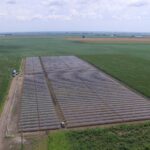Energy News Beat
Community solar is inherently a way to expand equity in solar access, as advocates describe it, since it makes clean energy and savings accessible to people who lack the capital or the space to install their own arrays.
The Inflation Reduction Act has the potential to drive a boom in community solar development, with bonus tax credits for community solar that serves low-income residents or is located in low-income areas, in addition to the 30% Investment Tax Credit available to all solar projects.
Since the IRA offers direct payment in lieu of tax credits, it also makes it more possible for nonprofit organizations — which don’t pay taxes — to develop community solar.
But there are serious challenges to making sure low-income people are able to reap savings from community solar. Those challenges include the often onerous and intimidating process of qualifying a household as “low-income,” and the challenge of gaining trust and raising awareness among marginalized communities who have been largely left out of the clean energy shift.
Many states lack legislation that encourages and facilitates community solar development. And utilities also must cooperate, including by facilitating bill consolidation so people’s community solar savings are directly credited to their energy bill.
“This is smart policy,” said Rikkia Ramsey-Williams, national programs director for the Coalition for Community Solar Access, said of the IRA incentives. “The industry has really been looking to expand community solar, but it doesn’t always pencil out. The incentives allow the ability to do that. And what’s more exciting are the requirements to provide benefits to low-income customers. It’s not just about expansion, it’s making sure we’re serving the people who need to be served.”
During the first 30-day application period for solar and wind projects seeking the IRA low-income bonuses — 10% to 20% of a project’s cost — the federal government received 46,000 applications representing 8 GW, more than four times the amount of capacity available for the bonuses this year.
The Department of Energy’s dashboard shows applications representing almost 4 GW were filed under Category 4 of the IRA program, the category most suitable for community solar. It provides an extra 20% tax credit and requires that at least 50% of projects’ financial benefits go to low-income subscribers, and that they receive 20% bill savings.
That category’s total capacity for 2023 is only 700 MW.
“I think the cap is going to be a problem,” Ramsey-Williams said. “It will be an extremely oversubscribed program. The first thing we want to do as advocacy groups is approach Congress about lifting that cap. But that might be hard to do until the programs hit the ground.”
Community solar projects could also qualify for Category 1 incentives — a 10% tax credit — by locating in a low-income community or on Native American land. The applications are being reviewed, with 42 MW worth of Category 4 projects approved thus far. Those that don’t receive tax credit or direct pay allocations can reapply in a future cycle.
“The demand for the program is further proof that President Biden’s Investing in America agenda is delivering investments and opportunities in clean energy to communities that have been left behind,” says a December 4 press release from the U.S. Treasury Department, which administers the program along with the Department of Energy.
Half of the capacity within the low-income program is reserved for projects that meet additional criteria, including “where households spend the highest percent of their income on energy, and/or have had the lowest levels of historical investment, or are owned by emerging market participants, such as: tribal enterprises; tax-exempt entities including nonprofits, local or tribal governments; consumer or worker cooperatives; and emerging renewable energy companies,” as the Treasury Department press release puts it.
The documentation and planning required to apply for the bonuses is complicated, especially for entities that are new to the market. The federal government is accepting new applications on a rolling basis for that reason, as some couldn’t meet the initial deadline.
“Community solar developers are also navigating how they will take advantage of new IRA incentives,” notes the third-quarter 2023 report by the Solar Energy Industries Association and consulting firm Wood Mackenzie. “As in other segments, qualifying for any of the three available ITC adders will prove more difficult than originally expected due to complex requirements.”
In order for a community solar project to tap the low-income bonuses, they need to officially designate subscribers as low income. Each state determines how this will be done. In some cases, individuals need to provide tax returns and other documentation to prove they qualify. Advocates say this will make people reluctant to participate, and make it difficult for community solar developers to enroll low-income subscribers or reap low-income bonuses.
Federal law now allows LIHEAP funds — the longstanding federal energy subsidies — to be used for community solar subscriptions. LIHEAP eligibility can also be used as a measure of eligibility for low-income solar bonuses, as can enrollment in SNAP food assistance or other supportive programs.
States can also designate geographic areas as low-income, so that subscribers within that area automatically meet the criteria, rather than having to qualify based on their individual income.
A report by community solar developer Nautilus Solar Energy notes the IRA provisions will make it easier to attract investment for community solar.
“The new ITC provision will attract an additional pool of investors that will have the opportunity to enter into much simpler agreements with a developer while enjoying the benefits of the ITCs that year,” says the report. “Because of the extra incentives, developers will be able to reach more low-income customers and provide clean power at a higher discounted rate than they would otherwise pay to the local utility company.”
But, it continues, “to realize the full objective of the IRA and facilitate the adoption of community solar in low-income communities, there are several barriers that will need to be removed in the short run, namely the qualification of low-income customers, the integration and cooperation of the utilities, and program education and building trust in the low-income communities.”
Convincing low-income residents to subscribe to community solar is a challenge, especially in some states where predatory retail energy suppliers have targeted such communities with bad deals for clean energy.
“Trust is such an important part of this work,” said Sarah Gyurina, partnership development associate for Solstice, a community solar broker and subsidiary of the global company Mitsui. “Community solar is a hard concept to understand. And with the deregulated energy market the past two decades [in states like Illinois], there have been a lot of bad actors in the energy industry who have come through and created a lot of mistrust.”
Solstice and Illinois’s Cook County housing authority are trying to address the issue by training public housing property managers and behavioral health coordinators to answer questions and enroll residents at more than 100 housing authority sites. They offer community solar enrollment while taking applications for LIHEAP assistance, a process that residents are familiar and comfortable with.
“These programs have real benefits for the residents,” said housing authority spokesperson Marcus King. “We all should handle this with a sense of urgency. It’s advantageous as well as courageous to create these programs for our vulnerable and historically marginalized populations.”
Solstice co-founder and CEO Steph Speirs said the Cook County housing authority project is just one example of how “Solstice is accelerating our efforts to drive energy equity across the United States with growing trends under IRA.”
“Community solar farms were created to take advantage of solar power without having to own a home or have the right credit score,” Speirs said. “The target pool of beneficiaries is low-income communities that community solar is supposed to serve but [currently] does not. It’s an exciting time for the advent of low-income inclusion in community solar. It really does take dedicated focus, dedicated organizing skills, and dedicated partnerships to make this happen.”
Summit Ridge, the nation’s largest community solar developer, is among the companies who work with third party contractors to recruit low-income subscribers.
“You’re going to see a greater influx of subscriber acquisition companies — third parties who are really trying to work with low-income communities and housing authorities to receive that tax credit,” said Summit Ridge vice president of political and regulatory affairs Leslie Elder.
Summit Ridge has 40 community solar projects in northern Illinois, making it the largest community solar developer in the state. Utility ComEd consolidates community solar credits on customers’ bills and allows them to subscribe for up to 200% of their past energy use, with any “unused” clean energy going to other customers.
The IRA will allow Summit Ridge to increasingly prioritize community solar on large rooftops like warehouses, instead of farmland, said Elder. That alleviates tension over use of agricultural land for solar, and allows community solar in more densely populated areas.
Rooftop community solar is usually more expensive than ground-mounted community solar. It’s harder — if not impossible — to use panels that track the sun; roof repairs or rebuilding may be needed; infrastructure like AC ducts creates complications; and building owners may be leery of making long-term commitments, Elder noted. That’s where the incentives created by the IRA can make the difference.
“We are seeing projects on the margins of being able to pencil before, that can pencil now,” said Elder. “That’s why we can look at doing more of these rooftops. It’s how we can pull some of these projects off agricultural land, put them in urban epicenters where the load is, coupled with workforce development programs where you can pull in folks traditionally left out of the clean energy economy.”
Summit Ridge funded a workforce development hub on the West Side of Chicago that graduated its first class in July, and aims to train 10,000 people in 10 years. The training center is run by 548 Enterprises, a company launched in Chicago in 2019 to develop affordable housing in tandem with clean energy.
Along with the low-income tax credit bonuses, the IRA created the $7 billion Solar for All program wherein states, tribal governments, municipalities and non-profit organizations can apply for grants to make solar available to low-income households. Community solar projects that enroll individual households as subscribers are eligible for the program, which is run by the EPA.
“There’s a lot of synergy here,” Ramsey-Williams said. “If states have applied for Solar for All funding, they might want to look at how they’ll make themselves attractive for the industry.”
In December, Reactivate announced Illinois’s 100th community solar project, in Chicago Heights, a suburb south of Chicago where about a quarter of the population lives in poverty and more than a third of households are renters. Led by trailblazing Black entrepreneur Utopia Hill, Reactivate’s mission is to bring community solar to low-income and environmental justice communities. Reactivate has six more community solar projects totaling 10.5 MW in the works in low-income Northern Illinois areas that would be eligible for IRA incentives.
Reactivate’s projects are possible because of Illinois’s robust state solar program, with specific incentives for community solar and solar in low-income areas. Speirs of Solstice, which partners with Reactivate, said some Illinois subscribers will save 60% on their energy supply bills thanks to community solar.
Summit Ridge has similarly tapped the Illinois Shines state program to increase its community solar deployment.
Since 2017, Elder said, Summit Ridge has invested about $1 billion in Illinois on more than 100 projects in 35 counties, creating over 3,500 construction jobs. A 2017 state law created solar subsidies, and Illinois’s 2021 Climate & Equitable Jobs Act fixed problems that had initially created a glut of community solar applications, including unviable ones.
Now, Elder said, the IRA equity incentives are all the more reason for states to develop their own community solar programs, by passing community solar enabling legislation and creating incentive programs like Illinois Shines.
“How is the IRA going to change state programs, and how is that going to look in a couple years after we see the impact of federal policy on market behavior?” asked Elder. “We don’t know yet, but we’re very excited about the IRA.”
Related
The post IRA offers lucrative incentives for low-income community solar, but also creates new challenges appeared first on Energy News Beat.








